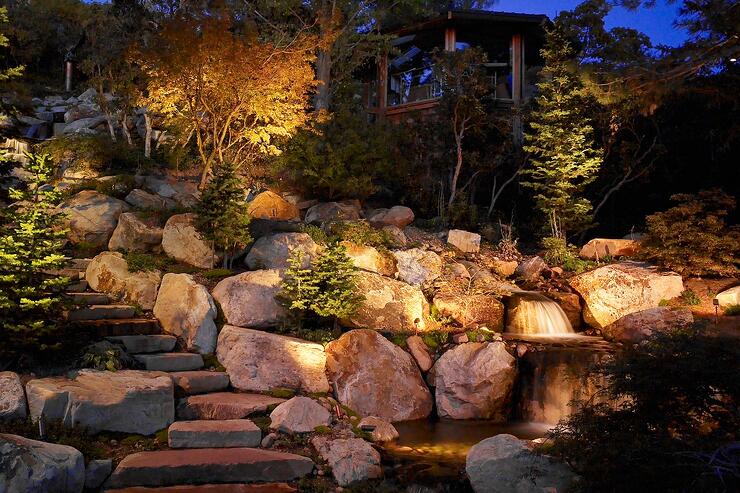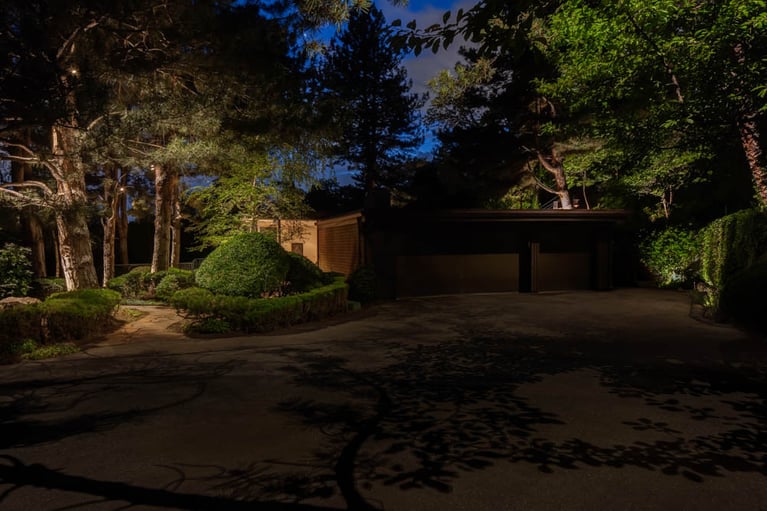Downlighting vs. Uplighting: Which Landscape Lighting Do You Need?
After dark, your outdoor living space glows. The architectural detail of interesting trees and a stone retaining wall are naturally illuminated. Beds of blooming perennials are highlighted so you can enjoy their beauty after sunset.
You don’t see the landscape lighting. You can feel it.
Done right, you won’t spot fixtures or feel like you’re sitting in an arena. Effective landscape lighting should not feel like you flipped on an overhead switch that floods your property with light. High-voltage is not the effect you’re going for.
So, what’s the secret to achieving that subtle, natural lighting effect? A combination of downlighting and uplighting in the landscape will accent focal points and architectural detail, create an inviting mood, building property value, and improve safety.
Let’s talk about the difference between downlighting and uplighting, and how both professional landscape lighting effects play well together to enhance your outdoor environment at night.
Uplighting

Spotlights and well lights are positioned to shine upward to illuminate structures. The positioning of light will accent texture and shape– a tree’s leaves and branches, for example. Uplighting draws the eye up, creating depth in the landscape at night. Upighting can shine directly on a surface, like a wall or tree trunk. Or, it can be positioned to light up and under a feature, such as a tree’s canopy. Depending on how uplighting is positioned, the effect can look crisp and modern by creating columns of light–or naturally dramatic, by shooting light up into and behind a feature to create a contrast of light and shadow.
Tip: First, pinpoint features you’d like to accentuate on your property. What are its focal points? Some ideas: architectural columns on your home or from a pergola/patio structure; or even interesting trees.
Downlighting:

With downlighting, fixtures are mounted up on to structures so light shines down and accents what lies beneath. Downlighting works for landscape beds, a water feature or any other ground-level focal point of functional space you want to illuminate after dark.
Tip: the key to creating a natural effect is to conceal the light fixture, if possible. Downlighting fixtures can be tucked into a tree canopy or behind natural stone or another hardscape element. You should notice the features that are illuminated, not the fixture of beam of light shining from it.
Layering Light: Combining Uplighting and Downlighting
Trying to determine whether uplighting or downloading is best for your property? The good news is, probably both. Layered landscape lighting that combines uplighting and downlighting creates the most appealing effect. If you think about it, natural light pours in from different angles. Your landscape lighting should amplify what nature can do, while maintaining a subtle, warm feel.
Uplight features that will accent your property’s character– interesting trees and architectural details.
Downlight focal points at ground level that might otherwise get lost in the dark. Think: low-growing plants, hardscape elements, water features.
Landscape lighting is an art and science.
Let’s talk about how you can ring your property to life after dark. Call us any time at 801-440-7647, or fill out this simple contact form and we’ll get in touch with you.
Salt Lake City (Midvale)
801-440-7647
St. George
435-932-6627
©2025 Landscape Lighting Pro
Privacy Policy
Cookie Policy